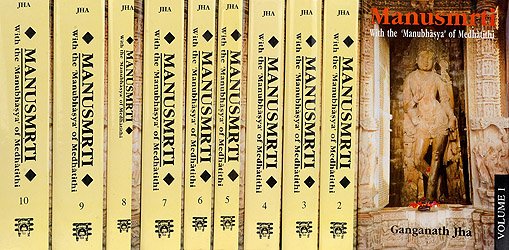Manusmriti with the Commentary of Medhatithi
by Ganganatha Jha | 1920 | 1,381,940 words | ISBN-10: 8120811550 | ISBN-13: 9788120811553
This is the English translation of the Manusmriti, which is a collection of Sanskrit verses dealing with ‘Dharma’, a collective name for human purpose, their duties and the law. Various topics will be dealt with, but this volume of the series includes 12 discourses (adhyaya). The commentary on this text by Medhatithi elaborately explains various t...
Verse 12.95
Sanskrit text, Unicode transliteration and English translation by Ganganath Jha:
या वेदबाह्याः स्मृतयो याश्च काश्च कुदृष्टयः ।
सर्वास्ता निष्फलाः प्रेत्य तमोनिष्ठा हि ताः स्मृताः ॥ ९५ ॥yā vedabāhyāḥ smṛtayo yāśca kāśca kudṛṣṭayaḥ |
sarvāstā niṣphalāḥ pretya tamoniṣṭhā hi tāḥ smṛtāḥ || 95 ||Those ‘revealed texts’ that are outside the Veda, as also all the false theories, are useless, even when carried to perfection; as they have been declared to be founded on ‘darkness.’—(95)
Medhātithi’s commentary (manubhāṣya):
Having declared the trustworthiness of the Veda on the ground of its not being the work of an author, the text proceeds to point out the untrustworthy character of those ‘Vedas’ that are the work of personal authors.
The ‘revealed texts’—in the form of Injunctions brought together under a compilation—‘that are outside the Veda’ contrary to the Veda,—e.g., such declarations as ‘Heaven is attained by bowing to caityas’ and so forth,—which are known under the name of the doctrines of ‘Nirgranthas,’ ‘Somas,’ and the like.
‘False theories’—philosophical systems based upon wrong reasonings—such as, the proving of the Veda being the work of a personal author, the rejecting of ‘apūrva,’ ‘deities’ and such other entities. These are what are known as ‘false theories.’
‘All these are useless,’—‘pretya,’ ‘even when carried to perfection’—by the full setting forth of reasons and examples; these are declared to be useless; on account of the fallacious character of their reasonings.
They are like the ‘darkness’ of night, on the path of duty, spreading far and wide, in the form of huge compilations.
No trustworthiness can attach to the teachings contained in the compilations made by human authors; for the simple reason that such authors do not possess the faculty to perceive things beyond the senses.
In fact, even if some one did possess such a faculty, people would not believe him; because there can be no proof for the statement that ‘such and such a person is omniscient, and he has composed such and such a revealed text.’
If, even on being the work of a human author, the text be regarded as trustworthy, this would involve the necessity of assuming an unseen fact (of the man being possessed of divine powers), for a visible purpose. For all these reasons all those reasonings should be regarded as based upon ignorance.
Others explain the verse to mean that, ‘pretya,’ after dying,—‘the said texts and theories are useless,’—because they become the cause of men being born in conditions partaking of the quality of ‘Tamas.’
Under this explanation, the syntactical connection of the participle ‘pretya’ would be impossible, since it must have the same nominative as that of the principal verb in the sentence (which is impossible), and the only alternative would be to read, for ‘pretya,’ ‘prete,’ the Locative form of the past-participle ‘preta.’— (95)
Explanatory notes by Ganganath Jha
‘Pretya’—‘Having acquired excellence’ (Medhātithi);—‘after death’ (‘others’ in Medhātithi, Govindarāja and Kullūka).
